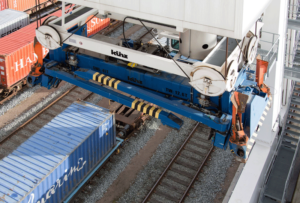Multimodal transport, also known as intermodal transport, i.e. the movement of goods using a combination of rail, road, water, and air in a coordinated and integrated manner, is being increasingly promoted in Europe as a significant contributor to the reduction in carbon emissions generated by trucks.
In France, the Grenelle Environment Forum in 2007 laid the foundations for a national strategy for sustainable development. In consultation with the French and European public authorities, various projects have been launched to increase the modal share of non-road for the transport of goods. This involves, among other things, improving multimodal services to French ports.
The Grand Port Maritime du Havre (GPMH) therefore decided to establish an innovative terminal allowing the mass approach to rail and river services at the port of Le Havre, at the same time opening new perspectives for supply chain organisation for its users.
LHTE (Le Havre Terminal Exploitation) became the operator of this new terminal with a target of eventually processing 200,000 TEUs p.a. “The Terminal, developed as a tool to promote multimodal transport, specifically in relation to the sea terminals at the port of Le Havre, became operational in 2015,” says LHTE’s CEO Christophe Regnier, adding that the project worth €140 million was, to a greater part, subsidized by the EU with the participation of various local and regional entities, and a balance of €25 million being brought by the private sector.
He explains that Le Havre Multimodal Terminal – one of Europe’s biggest – is located about 15 kilometres behind the Port of Le Havre and serves to maximise the volume of containers moved by trains or barges to and from various points in France.
 Balanced performance
Balanced performance
The Terminal is ideally positioned near the Le Havre Industrial Zone, along the Grand Le Havre Canal, and connected to the National Rail Network by an electrified track and meets the key criteria for modern-day logistics. The Terminal currently offers 2 river berths plus 2 associated gantry cranes, and 10 rail lines and 2 associated gantry cranes for cargo handling.
Christophe Regnier, with 30 years of experience in the industry, has been involved in the Terminal project since its conception in 2011, and as LHTE’s CEO has personally driven its growth, which has been impressive. Since the start of the operation, the Terminal has handled over 15,000 trains and 5000 river units that have altogether transported some 700 thousand containers.
“We had a great year in 2022 and almost reached our target of 100,000 containers but last year’s result was affected by events in the global as well as local environments – reduced consumption meant reduced global transport, combined with social issues and strikes in France at the beginning of the year, significantly affected our operation. The reduction in international traffic in general was further accentuated by a certain relocation of production back from Asia to Europe.”
Still, he points out that despite these challenges, the company has maintained its profitability, a remarkable achievement in its own right. “In an inflationary environment, increasing our tariffs has its limits as we wouldn’t be competitive with road transport. So, we have to be very careful with balancing profit and loss. In this respect, we have been successful.”
Employing artificial intelligence
He admits that to persuade more operators to switch from road to multimodal requires further service enhancement, “At the moment, 85% of the containers freight transiting through the port of Le Havre is collected and transported onward by trucks, with only 15% left for trains and barges. Our target, which we believe is realistic, is to reach 20%. This is, of course, a challenge, and we need to further improve efficiency and reliability, in order to give operators confidence that their cargo will reach its destination on time and as desired.”
A lot has already been done to this end. The management of the container fleet is fully computerised allowing LHTE to know in real time the location of each container in transit or parked, whether on train, on barge or on the ground.
This makes it possible to record all movements of containers on the park, direct transhipment on truck or shuttle, or its storage location. The gantries, reach stackers as well as the company’s ground agents are permanently connected to the Terminal Operating System (TOS) which allows real-time updating of terminal activity.
As the need for digitisation increases, LHTE has employed AI to further improve its services. In collaborating with AllRead, a technology company specialising in OCR software, the company has established real-time control of container entry, exit and condition and, in particular, has improved traceability as well as the operational efficiency of the control process.
 Key role in multimodal shift
Key role in multimodal shift
To support the Terminal operation and increase the attractiveness of multimodal transportation, LHTE has also developed additional services to complement its core business and increase the value for transport operators. “Managing container traffic on trains and barges today accounts for 80% of our overall activities. The rest is additional services for the shipping companies, such as container repairs, container storage and similar,” explains Regnier.
The goal for the near and more distant future is to further increase the volumes that pass through the Terminal, he affirms. Configured in its current form to handle 130,000 containers p.a., there is still some spare capacity available but at the same time, provision has been made for further expansion to reach the targeted 200,000 units projected for the next five decades.
“Naturally, the expansion will be related to the growth of activities at the Port of Le Havre as well as development within a wider context. Transport by rail has a high priority these days but to shift more cargo from trucks to trains will require long-term, major investment on a larger scale, including developing the rail infrastructure enabling rail connections to other countries. Only then can we expect more traffic to be diverted from roads to rail. The potential is there, and the multimodal Terminal is set to play an important role in making this happen.”








